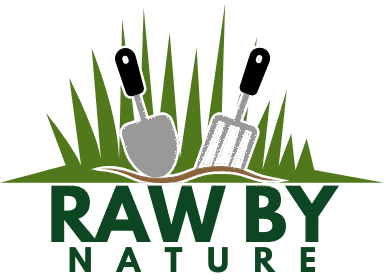Houseplants have a magical way of transforming any living space into a lush, vibrant oasis, offering a breath of fresh air and a touch of nature’s tranquility. For those just dipping their toes into the verdant world of gardening, houseplants present a perfect starting point, providing both seasoned green thumbs and fledgling gardeners with the opportunity to nurture life indoors.
Whether you’re an experienced gardener seeking to expand your indoor collection or a beginner excited to cultivate your first leafy companion, this guide is crafted with you in mind. We will explore a selection of houseplants that are not only visually stunning but also remarkably easy to care for, ensuring that your foray into indoor gardening is a rewarding journey.
In the pages that follow, you’ll discover which plants are best suited for novices, learn about their unique characteristics, and gather practical tips on how to help them thrive. By the end of this article, you’ll feel equipped and inspired to select the perfect plants that align with your lifestyle, making your home a place of beauty and serenity. Let’s embark on this green adventure together, where every leaf unfurls a story and every pot holds the promise of growth.
Choosing Beginner-Friendly Houseplants

When choosing beginner-friendly houseplants, it’s essential to start with species that thrive in a variety of conditions. Plants like pothos, snake plants, and peace lilies are resilient and can tolerate occasional neglect, making them ideal for new gardeners.
Avoid choosing plants that require precise humidity or lighting conditions, as these can be challenging to maintain. Instead, opt for those that can adapt to indirect light and typical household humidity levels, such as the spider plant.
Watering frequency is another crucial factor to consider; beginner-friendly plants often prefer to dry out between waterings. For instance, succulents and ZZ plants require less frequent watering, reducing the risk of root rot from overwatering.
To ensure success, use a well-draining potting mix suitable for the specific type of plant.
- For succulents, a cactus mix is ideal.
- For foliage plants, a general-purpose indoor potting soil usually works well.
This will help prevent waterlogging and promote healthy growth.
Understanding Light Needs Indoors
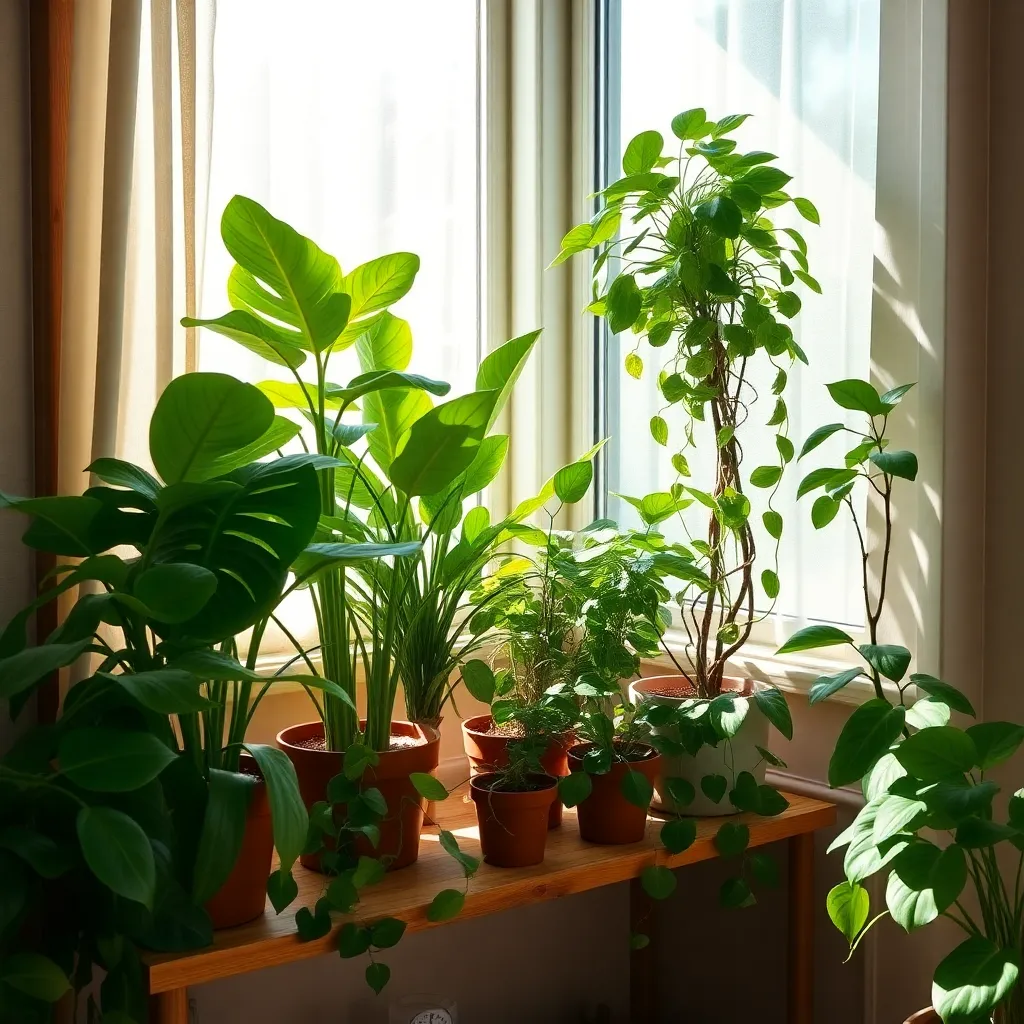
Understanding the light needs of your houseplants is crucial for ensuring their health and growth. Most houseplants thrive in environments that mimic their natural habitats, so it’s important to consider the light conditions in your home.
Begin by assessing the light levels in different rooms throughout the day. East-facing windows typically offer bright, indirect light, ideal for most houseplants, while south-facing windows provide the most intense light, suitable for sun-loving plants like succulents and cacti.
For rooms with low natural light, consider using grow lights to supplement your plants’ needs. These lights can be especially helpful in winter when daylight is scarce, and they come in various forms, including LED and fluorescent options.
When positioning your plants, pay attention to their specific light requirements. Spider plants and pothos are forgiving and can tolerate lower light, making them perfect for beginners. In contrast, plants like the fiddle leaf fig demand bright, indirect light to flourish.
Experiment with plant placement to find what works best for each species. It may be necessary to rotate your plants every few weeks to ensure even light distribution, which can help prevent uneven growth.
In addition to light, consider other factors like temperature and humidity, as these also impact how well your plants will grow indoors. By understanding and adjusting these elements, you can create an optimal environment that encourages healthy plant development.
Simple Watering Tips for Novices
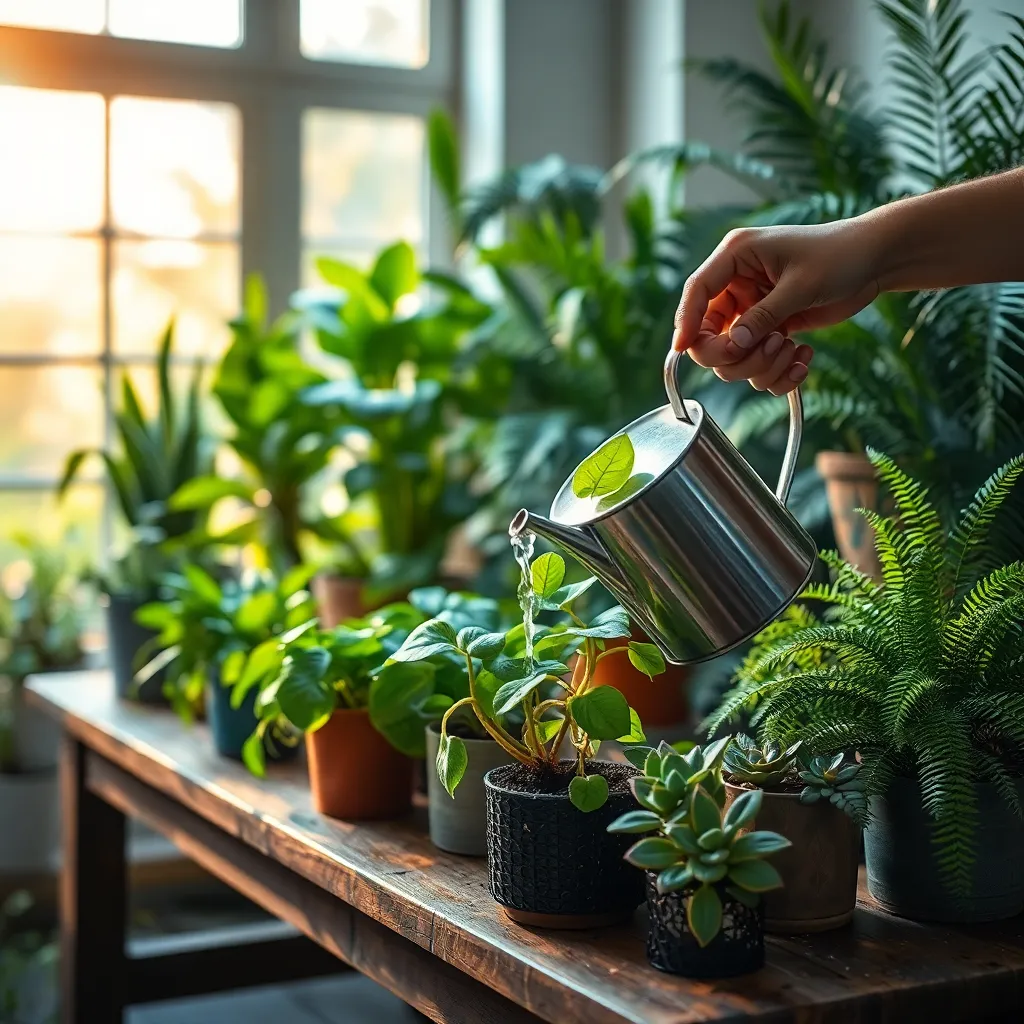
Watering is a fundamental aspect of plant care, and getting it right is crucial for the health of your houseplants. For beginners, it’s important to remember that overwatering is a common mistake, often more detrimental than underwatering.
It’s helpful to understand the specific watering needs of each plant species. Some plants, like succulents, prefer their soil to dry out completely between waterings, while others, such as ferns, thrive in consistently moist soil.
To determine when to water your plants, insert your finger about an inch into the soil. If it feels dry, it’s time to water; if it’s still moist, wait a few more days before checking again.
Avoid using cold water from the tap, as this can shock the roots. Instead, let water sit at room temperature for a few hours before using it, ensuring it’s gentle on your plants.
For those looking to refine their watering technique, consider investing in a moisture meter. This tool provides an accurate reading of soil moisture levels, helping you avoid the guesswork and maintain optimal conditions for your plants.
Lastly, always make sure your pots have drainage holes to prevent water from pooling at the bottom. Good drainage prevents root rot, a common issue that can severely damage or kill your plants.
Basic Houseplant Soil Guide
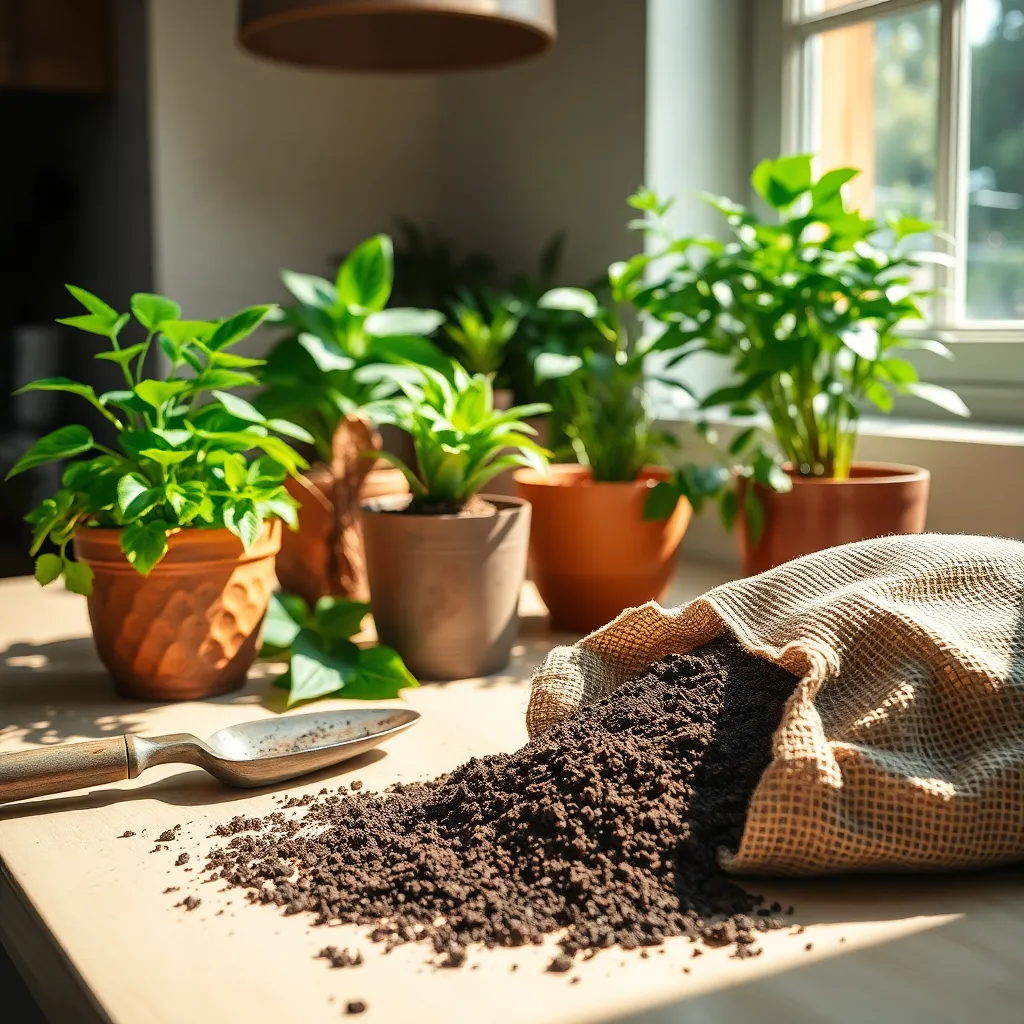
Choosing the right soil is crucial for your houseplants’ health and growth. Most houseplants thrive in a well-draining potting mix, which prevents water from pooling at the roots and causing rot.
A general potting mix usually contains a combination of peat moss, bark, and perlite. Peat moss retains moisture, while perlite and bark improve drainage and air circulation around the roots.
For specific plants, you might need specialized mixes to meet their unique needs. For instance, succulents and cacti prefer a gritty, fast-draining soil, which you can create by adding extra sand or perlite to a standard potting mix.
Always consider the environment in which your plant is growing. If your home is very dry, you might opt for a mix that retains more moisture, while a humid environment could benefit from a mix with enhanced drainage properties.
Troubleshooting Common Plant Issues
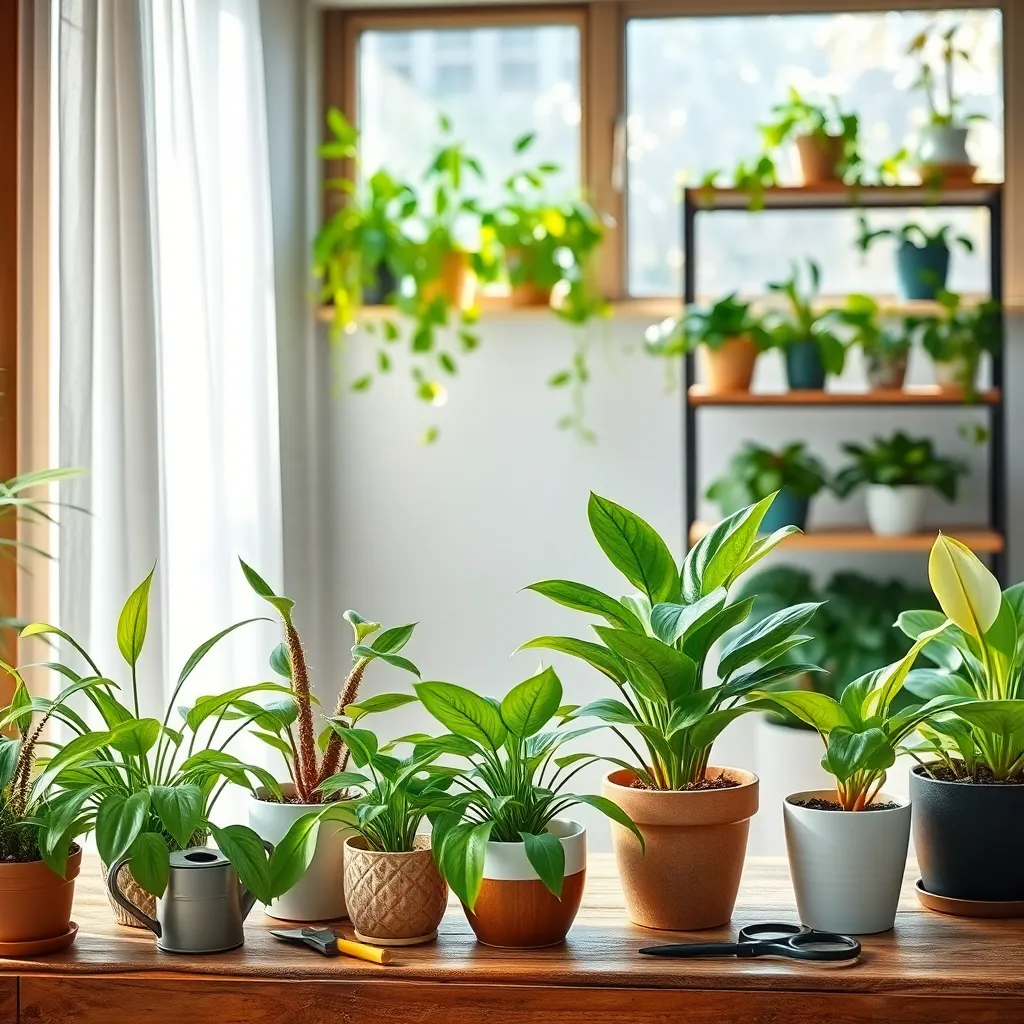
Houseplants can sometimes show signs of distress, but identifying the problem is the first step to recovery. Yellowing leaves often indicate overwatering or poor drainage, so check the pot for excess water and ensure your plant has a well-draining soil mix.
Another common issue is drooping leaves, which can be a sign of underwatering. Examine the soil moisture level by sticking your finger about an inch into the soil; if it feels dry, it’s time to water your plant thoroughly.
For leaf spots or discoloration, consider the possibility of pests or fungal infections. Regularly inspect your plants for signs of insects, and if needed, use an insecticidal soap or a homemade solution of water and dish soap to gently clean the leaves.
Ensure your plants receive the right amount of light, as insufficient light can lead to leggy growth. If a plant looks stretched and weak, consider moving it closer to a light source or using a grow light to supplement natural sunlight.
Keep in mind that temperature fluctuations can also stress your plants, leading to wilting or leaf drop. Maintain a stable room temperature and avoid placing plants near drafts or heating vents to ensure a consistent environment.
Conclusion: Growing Success with These Plants
In exploring the intersection of nurturing houseplants and cultivating healthy relationships, we’ve uncovered five fundamental parallels. Firstly, like relationships, plants require consistent attention and care. Secondly, understanding the unique needs of each plant mirrors the importance of recognizing and respecting individual differences in partnerships. Thirdly, patience is key; growth, whether in plants or bonds, takes time. Fourthly, adaptability plays a crucial role as we learn to adjust to changing circumstances in both gardens and relationships. Lastly, communication is vital, akin to how plants signal their needs through subtle cues.
As an actionable next step, take a moment today to identify one area in your relationship that could benefit from a little more nurturing, be it through a heartfelt conversation or a simple loving gesture. This small action can plant the seeds for future growth.
Remember to bookmark this article as a handy guide to revisit whenever your relationship requires a little extra tending. By applying these insights, you’re not only investing in the present but also paving the way for a flourishing future filled with love and understanding. Here’s to growing stronger, together.
